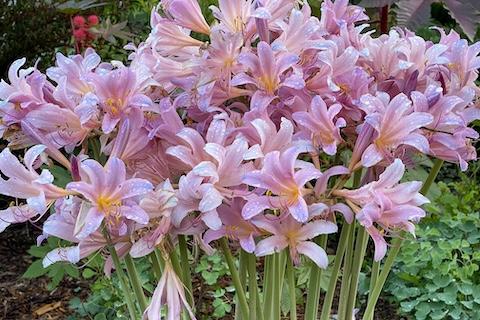This reliable bloomer surprises gardeners every summer
As we enter the last days of summer and gardens begin their transition to autumn, one common garden bulb surprises us with its beautiful and unexpected blooms: the surprise lily.
This late-season bulb is known by many names, including surprise lily, Lycoris squamigera, magic lily, resurrection lily or even naked lady. While not a true lily, it is in the closely related Amaryllidaceae family and is native to Japan.
The plant's unique life cycle has made it a beloved oddity in Midwestern gardens; long, strap-like leaves emerge in spring, only to die back by early summer. This disappearance often goes unnoticed as it aligns with the dieback of foliage for many spring bulbs like daffodils. In late summer, a tall, leafless flower stalk emerges, with clusters of delicate pink, lily-like blooms and prominent, long stamens.
Aaron Steil, consumer horticulture specialist at Iowa State University, noted that these blooms appear "seemingly overnight," adding to their magic.
"Each stalk can produce between four and 12 flowers, standing 18 to 24 inches tall. Gardeners who inherit new landscapes are often the most surprised as these blooms resurrect from what seems like nothing, which leads to questions about an unusual, leafless flower they never planted."
For those looking to cultivate surprise lilies, Steil recommends planting bulbs in the fall about 5 to 6 inches deep and spaced 6 to 8 inches apart. Surprise lilies thrive in well-drained soils and prefer partial shade to full sun. Because the dying foliage is unattractive and flower stalks are relatively tall, Steil said it's best to interplant surprise lilies with other perennials in the middle or back of the garden border.
"Growing the bulbs among open or airy perennials like threadleaf coreopsis, perennial geranium or prairie dropseed can be particularly nice," he said.
Bulbs quickly multiply, forming large clumps of blooms that can be propagated and shared every four to five years. Dig clumps after the foliage dies back in early summer or after flowering in late summer. Then, separate the bulbs and share them with neighbors or tuck them in new corners of your own garden.
Steil also suggests having a little fun and secretly planting them in a friend's garden to double the surprise next year!
For related content and more information, visit:
.jpg)
.jpg)


.jpg)



.jpg)


Comments
Submit a CommentPlease refresh the page to leave Comment.
Still seeing this message? Press Ctrl + F5 to do a "Hard Refresh".